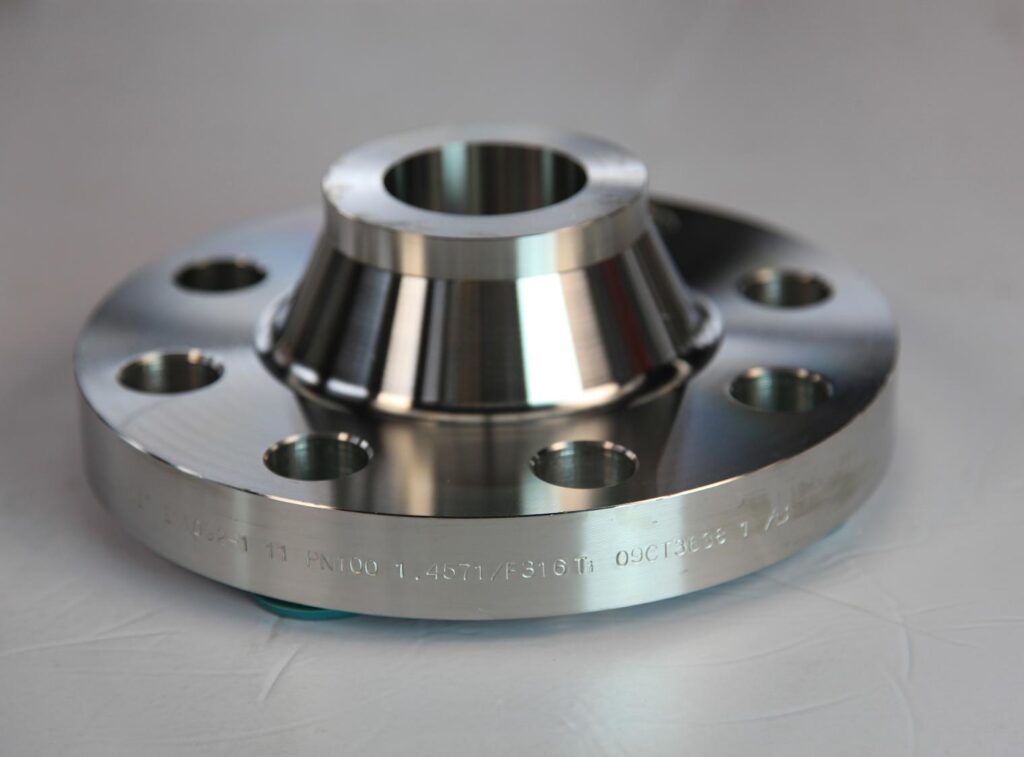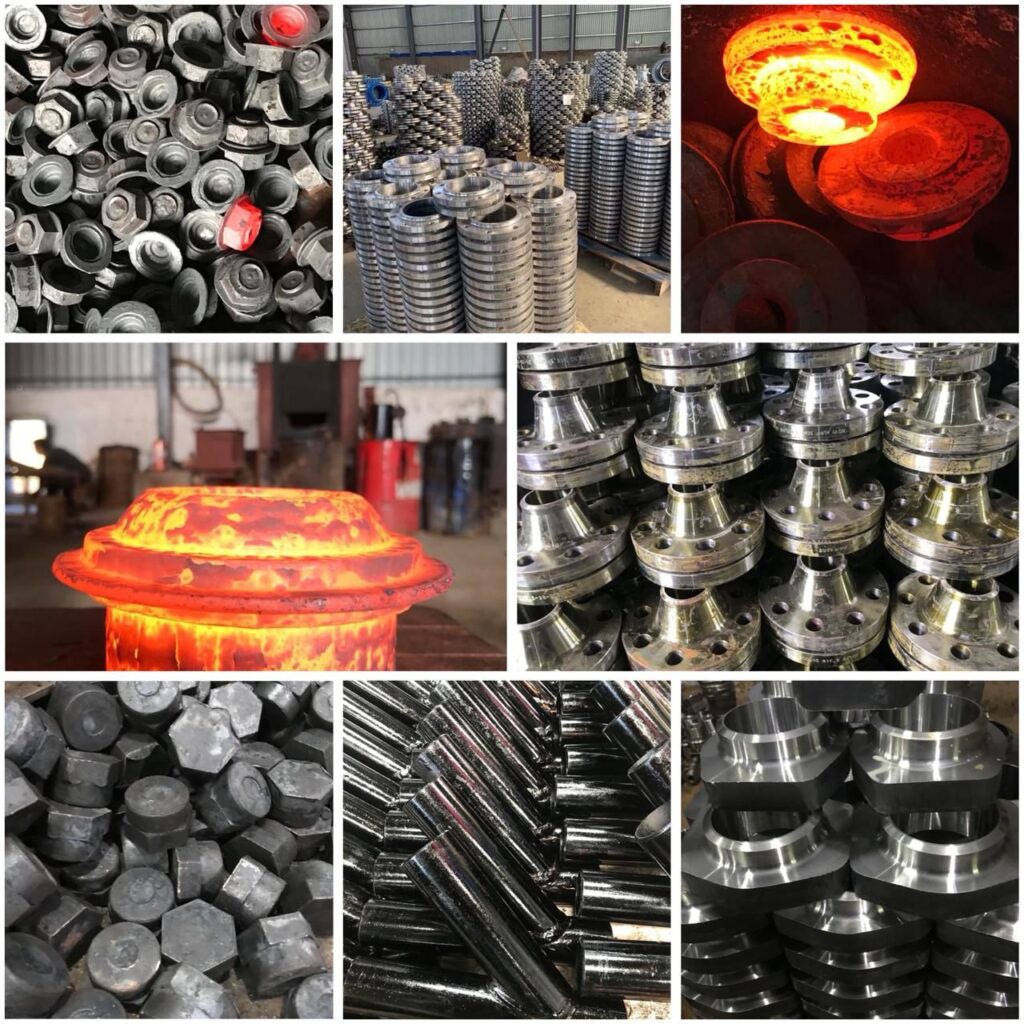ASME B16.5 Flange Manufacturer
As a trusted ASME flange manufacturer and global exporter, we deliver high-precision ASME B16.5 flanges built to perform in the most demanding environments—from oil & gas and petrochemical plants to power stations, shipyards, and industrial process facilities. Engineered to meet rigorous standards, our ASME flanges offer exceptional durability, tight sealing, and seamless integration across high-pressure and high-temperature systems. With a wide range of configurations and pressure ratings, they’re the backbone of reliable flow control in mission-critical piping networks.

Why choose an ASME B16.5 flange?
- Universal Standardization ASME B16.5 is recognized worldwide, ensuring consistent dimensions, tolerances, and pressure ratings across manufacturers. That means easier sourcing, interchangeability, and fewer surprises during installation.
- Wide Pressure & Size Range Covers flanges from ½ inch to 24 inches and pressure classes from 150 to 2500, making it suitable for everything from low-pressure steam lines to high-pressure oil pipelines.
- Material Versatility Supports a broad spectrum of materials—carbon steel, stainless steel, alloy steel, and more—allowing engineers to match flange performance to environmental and process demands.
- Design Integrity Engineered for high-pressure, high-temperature, and cyclic-load conditions, these flanges are built to last in critical systems like refineries, power plants, and chemical facilities.
- Comprehensive Coverage Includes multiple flange types—weld neck, slip-on, blind, threaded, socket weld, lap joint—each tailored to specific installation and performance needs.
- Safety & Compliance
ASME vs ANSI — Are they the same?
ASME (American Society of Mechanical Engineers): Provides mandatory, code-level rules used for design, fabrication, inspection, testing, and stamping of pressure equipment (e.g., boilers, pressure vessels, piping systems). Commonly referenced where legal or regulatory compliance is required.
ANSI (American National Standards Institute): Accredits voluntary consensus standards developed by other organizations. ANSI standards focus on interoperability, dimensions, safety signs, and general industry practices rather than code-stamped equipment.
Dimensionally and functionally, ANSI and ASME flanges are the same in common practice. Standards like ANSI B16.5 are identical to ASME B16.5 in content and provide the same face‑to‑face dimensions, pressure‑temperature ratings, bolt patterns, and raised/flat face types used for interchangeability. Thus, for the ASME flange manufacturer to end-user, no need to worry.
Historically “ANSI” named standards; many were later published or jointly maintained by ASME. Today you’ll often see the same spec referenced as ASME B16.5 (formerly ANSI B16.5).
Practical takeaway: If your spec calls for ANSI B16.5 or ASME B16.5, they refer to the same flange dimensions/ratings and are compatible. Always confirm the exact standard revision (year) and material/class required in your purchase or engineering spec to avoid ambiguity.
Standards & certifications
- Standard: ASME B16.5 — Pipe Flanges and Flanged Fittings (covering NPS 1/2 through NPS 24 and pressure classes 150–2500).
- Design & manufacture: ASME, ANSI, ASTM, DIN (on request), and customers’ proprietary specs.
- Quality systems: ISO 9001 certified manufacturing.
- Material and testing: EN/ASTM material specs, 3.1/3.2 material certificates (IV), PMI, UT, RT, MPI/PT as required.
- Traceability: Mill test reports (MTRs), NDT reports, heat treatment records, welding procedure specifications (WPS/PQR), and material traceability from heat to part number.
Materials, pressure classes and sizes we supply
We fabricate ASME B16.5 flanges from a wide range of materials to match process conditions:
- Carbon steels: A105, A350 LF2 (low-temperature service)
- Stainless steels: SS304, SS304L, SS316, SS316L, Duplex (2205), Super Duplex (2507)
- Alloy steels: ASTM A182 F11, F22, F5, F9, F91
- Nickel alloys: Inconel 625/825, Monel
- Copper-nickel and specialty alloys (upon request)
Manufacturing process & quality assurance

- Raw material procurement: certified seamless/heavy plate material from qualified mills.
- Cutting & profiling: CNC cutting or oxy-fuel/plasma for larger sizes.
- Forging/rolling: Forged hubs for pressure classes requiring higher strength; rolled plate machining where applicable.
- Heat treatment: Normalizing, quenching & tempering, or annealing as required by material spec.
- CNC machining: Face finish, bore, hub taper, and flange thickness to ASME tolerances.
- Drilling & facing: Bolt-hole pattern, raised face/RTJ groove, and finish to specification.
- NDE & inspection: Visual, PMI, UT/RT/MPI/PT per order.
- Cleaning & coating: Pickling/passivation for stainless, varnish/primer/packing for export.
- Documentation & packaging: MTRs, NDT reports, WPS/PQR, and export-grade packing.
- Product types & facing options
Industrial Standard: ASME B16.5 Flange
| Flange Type | Description |
| Weld Neck | Long tapered hub; ideal for high-pressure/high-temp systems |
| Slip-On | Slides over pipe; easy to install, good for low-pressure applications |
| Socket Weld | Pipe inserted into socket; used for small-diameter, high-pressure piping |
| Threaded | Screwed onto pipe; useful where welding isn’t feasible |
| Blind | Seals pipe ends; used for pressure testing and isolation |
| Lap Joint | Used with stub ends; allows easy alignment and dismantling |
| Reducing Flange | Connects pipes of different sizes |
| Long Weld Neck | Extended hub; often used in high-pressure vessels |
- Material options: A105 (mild steel), SS304, SS316, Alloy steel, etc.
- Facing options: Raised Face (RF), Ring Type Joint (RTJ), Flat Face (FF), Tongue & Groove (specials).
- Bore options: Full bore, reduced bore, counter-bored for specific piping.
- Pressure classes & size range (ASME B16.5)
- ASME B16.5 covers NPS 1/2 through NPS 24 for flange pressure classes 150, 300, 400, 600, 900, 1500, and 2500. Below is an industry-oriented summary table of typical sizes, materials, and recommended applications.

Industrial data — ASME B16.5 Flange (summary table)
| NPS (inch) | Pressure Class (common) | Typical Material | Typical Face | Typical Use / Application |
| 1/2 – 2 | 150, 300 | A105 / SS304, SS316 | RF, FF | Instrumentation, utility lines |
| 2-1/2 – 6 | 150, 300, 600 | A105 / SS316 / Duplex | RF, RTJ | Refinery, chemical process piping |
| 8 – 12 | 150, 300, 600, 900 | A105, A182-F11, SS316L | RF, RTJ | High-temp steam, heaters |
| 14 – 20 | 150, 300, 600, 900, 1500 | A182-F22, Duplex | RF, RTJ | High-pressure oil & gas lines |
| 24 | 150–600 (common), up to 1500 | Alloy steels / Duplex | RF, RTJ | Large diameter trunk lines |
- Face flatness: per ASME B16.5 requirements.
- Surface finish: Raised face typically 250–500 µin Ra (6–12 µm) unless otherwise specified.
- Concentricity & bore tolerance: Machined to ASME tolerances relevant to pipe size and class.
Testing, certification and export documentation
- PMI / chemical composition check (for material verification).
- Hardness testing (HRC/HV) for heat-treated alloys.
- Radiographic testing (RT) or ultrasonic testing (UT) for critical pressure classes.
- Positive Material Identification Certificate (3.1/3.2), MTRs.
- Hydrostatic test of welded assemblies where applicable.
- Third-party inspection (TPI) by client-approved agencies (ABS, BV, DNV, Lloyd’s, SGS).
Packing, shipping and delivery options
- Individual wooden boxes / crates with anti-corrosion packing.
- VCI (Vapor Corrosion Inhibitor) paper and desiccants for humid routes.
- Marking: Part number, heat number, material, size, pressure class, and manufacturing date on each flange.
- Documentation pack: MTRs, inspection reports, packing list, commercial invoice, certificate of origin (if required), and export customs paperwork.
- Options: FOB, CIF, DDP quotes; container stuffing & lashing; bulk or project-by-project logistics.
Quality assurance & traceability
- Heat-to-part traceability recorded; unique serial/heat numbers laser-etched.
- Full MTRs (ASTM/EN) and 3.1/3.2 certificates issued by default.
- Welding records (WPS/PQR), NDT logs and inspector sign-offs available.
- Continuous improvement via process monitoring and internal audits.
Request a quote
For firm quotes: provide required NPS, pressure class, material grade, face type, quantity, and destination port/terms